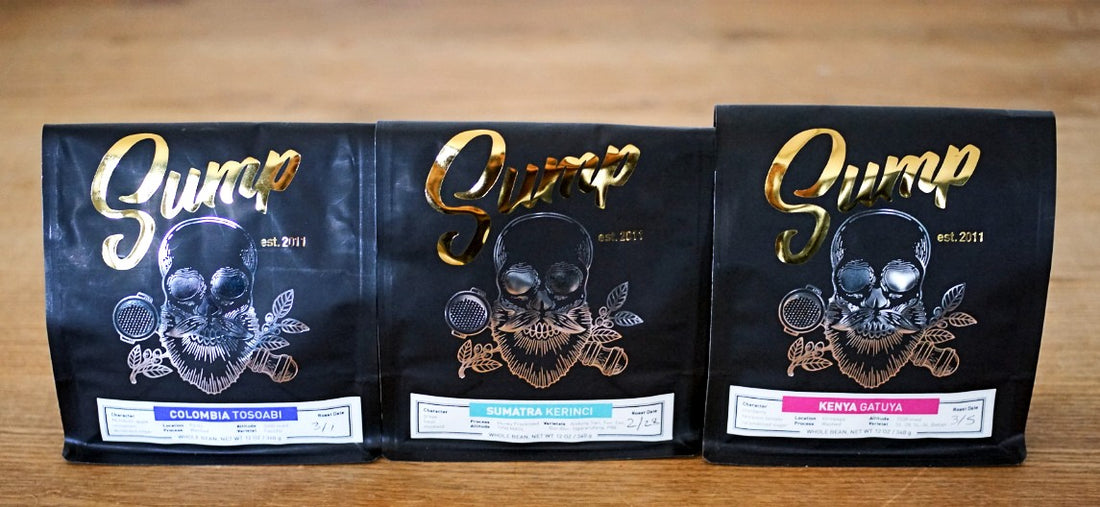Savory notes in coffee? It happens more than one might reflexively think. And not just with tomato-y leaning coffees from Kenya. What we grind and extract to make delicious beverages is a seed, from a fruit. We in coffee tend to make a big deal about this, some leaning hard into this fact as a major branding point or naming convention. But a quick Google search reveals beans are also edible seeds. So everyone’s right, then. What follows is largely sense experience findings and not from peer reviewed food science journals.
Underdeveloped/under roasted coffee often tastes legume-like. It’s legume-like with a hint of earth. This might be why coffee has historically been thought of as a bean versus a seed. Or maybe it was a marketing, Mad Men, focused group thing. Anyway, when we, at Sump, experience coffee that does not have the right roast profile (when we’re work-shopping a new arrival) we often flip between working from the sense impression of ‘bean’ (savory) and the sense impression of ‘seed’ (bitter). We constantly work to modulate the roast profile between those two impressions to produce impressions of ‘fruit’ and sweetness. So savory, is sometimes an accidental inherency, but often times intentional (some fruits are actually savory -jack fruit, egg plant, cucumber, tomatoes (actually), okra, pumpkin and olives).
The next question is, is the unexpected always to be avoided or feared? So is finding savory, inherently bad. We would argue, it has to be the right kind of savory (see the above again for clarity). We currently have a lovely honey processed Sumatra Kerinci in the shop with notes of concord grape, mustard seed and basil. It is f-ing delicious, but initially (even to the coffee indoctrinated) very incongruent as a concept (not as a flavor symphony in the cup), a concept to think around.
In addition, sometimes the extraction method can highlight savory over another brewing method that might mute it. A good example of this is extracting coffees as espresso. An under, or too tight an extraction (too short, maybe -but just in general ‘knotted’) usually hits us as briny/minerally or olive-like (also, this comment is not a general prescription or advocacy for proper espresso extraction). We usually modulate those types of impressions by extracting a longer or bigger (by volume) shot. But sometimes, and by design (cultivar, processing, luck, or favorite higher power (or combination thereof)), we get a big concord grape, mustard seed and basil coffee experience and that is just beautiful to us.
Another example would be our Kenya Gatuya AA, we hunted around, across several roast profiles for an expression that keep the heirloom tomato character of that cup in balance with the other expressions of dark sugar and cranberry. Kenya coffees are often tricky with respect to savory impressions, because temperature of the coffee plays a huge role in how prominent the savory profile is perceived. We have had freshly brewed Kenya coffees (from ourselves and other roasters) and right off brew temperature it was all spinach and tomato, only to morph into something sweet, with dark sugars and hints of dry red cranberry and blood orange grapefruit at room temperature. This is not unlike a wine. I recently had the experience of someone sharing a very special bottle of bordeaux (it was aged, stored at a professional wine storage facility, the whole nine and apparently one of the best vintage in relatively recent history for the producer -super fancy, beyond my pay grade, etc. you get the idea). It was opened and the sharer meticulously curated when we could start the first pour, when to decant, how not to tip the bottle before pouring, and on and on. Over the course of the evening that wine began at one set of sense impressions and finished at a totally different set of sense impressions.
A further example of savory in coffee are some recent coffees/lots from Colombia. We have been told, that because of a particularly bad leaf rust year in 2012 there was a big initiative to replant and replace cultivars more vulnerable to leaf rust with those less susceptible. So harvests that were largely typicia and bourbon are now largely composed of caturra, caturi, and colombia (or the like). This change, in our opinion, has increased the suggestion of savory in the these coffees coming from Colombia (at the very least in the aromatics (sometimes producing strong stew like aromatics)). All very delicious coffees, but a change cup characteristic overall. Suggestions of this can be seen around the edges of our Colombia Duarte and Tosoabi from Narino. They are not the strongest examples of savory in coffee, but we at the shop can still think them present. We find these coffees lean more into seed sense impressions/characteristics..
All of this is to say, savory in coffee is not inherently evil. As in most things in life, it depends. If it tastes like legume water from start to finish no matter what the beverage temperature or extraction method -then it is inherently evil. If it is part of a symphony of complexity, that can be articulated beyond ‘bean’ as a note, that has an interplay with the rest of the elements of the cup and that evolves with you as the cup cools and as more of the coffee coats, lays, oxidizes, sweetens, lingers, and explores your palette then it is part of the rich, luxurious and intentional experience that drinking a special coffee can be about.
All the coffees mentioned above are small lot coffees and will be available only in our STL and Nashville stores.


